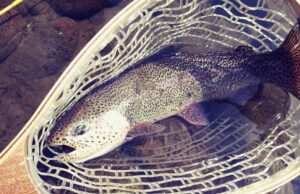River Fishing tips
River fishing is my favorite pastime. The sound of the water and the visual satisfaction of moving water allow me to escape to my happy place. I have been fishing for over 50 years and have learned a few things. Most of what I’m about to share isn’t complicated and some of may be obvious. But, it can be useful the next time you find yourself fishing on a river, creek or stream. If you are new to fishing check out my Learning to fish post.
I love fly fishing, but I catch most of my trout with a spinner. So that is what I’m going to focus on in this post. Note, I live near the rocky mountains where trout fishing is popular. If you find these tips to be helpful, please consider ordering some fishing gear from any of the Amazon affiliate links on this site. I receive a small commission on qualified sales. Thanks for your support!

River fishing spinners
- Water temperature can tell you how aggressive the fish are going to be. When fishing for trout it is difficult to get a reaction strike if the water temp is under 40 degree’s . This is a good time for fly fishing. A good time for spinners is above 45. I’ve had the most action between 50 and 55. And, if it gets above 65 degrees, I stop fishing for trout. The warmer water can stress a trout to death. This is a good time for Bass, catfish, walleye or your favorite warm water fish.
- Spinner selection can be the most dramatic factor in your success. A bright flashy spinner on a sunny day in clear water can actually spook the fish. All you need is to get some curiosity going. Most natural food for trout (if not all) is not that flashy. That’s why I recommend using darker lures. Such as the Panther martin, all black with yellow dots. It’s just enough , even on cloudy days, if the water is mostly clear. i only use flashy spinners on cloudy days or murky waters.
- When you find a nice pool, where the whitewater ends and the bubbles begin. Take a few short cast and try to catch the fish close to you. If you take the long cast and hook up, you will spook everything in the path of the catch. If you spook a pool, you can come back to it in 20 to 30 minutes. (fish have short memories )
- Try to keep the spinner in front of the fish. They are facing upstream waiting for food to come to them. Cast upstream at a 45 degree angle and try to reel at the same speed as the current. The current will drift the spinner in front of the fish. Then cast straight across the river ( 90 degree cast ) and do the same. Then take a 45 degree cast down stream and do the same. repeat a few times and move upstream 10 to 20 feet to reach a new set of fish. It’s hard to catch fish sneaking up behind them with a spinner. NOTE: If you have waders and it is safe to do so you can stand in the river and take all of your casts upstream. (My personal favorite)
- Use braided line with a 8 to 10 foot fluorocarbon leader. Braided line will reduce line twisting and fluorocarbon line doesn’t reflect sunlight like monofilament. I recommend Spider wire Translucent for braided line. it is white and has a coating of fluorocarbon on it. Reducing visibility below the water line. Line twisting will always be an issue when spinner fishing currents. But by casting upstream with braided line you should only need to replace the line once a year. I also suggest using a 6 1/2 foot ultralight fishing pole for trout fishing rivers.
- When I’m out on the river I’m looking for specify features in the river that I believe the fish are holding. For example, Pools where the water slows down. But I’m also looking for Rocks in the water. Fish like to hold in front of rocks as well as under. I like to finds shelfs where a few inches to a foot of slower water meets a faster current. But don’t be afraid to cast into strong currents, trout are everywhere. To help see underwater features like submerged rocks a recommend getting polarized lenses. They really make a difference when sight fishing or just getting a better view of hidden features.
For more tips, click on the video link below. Tight lines!